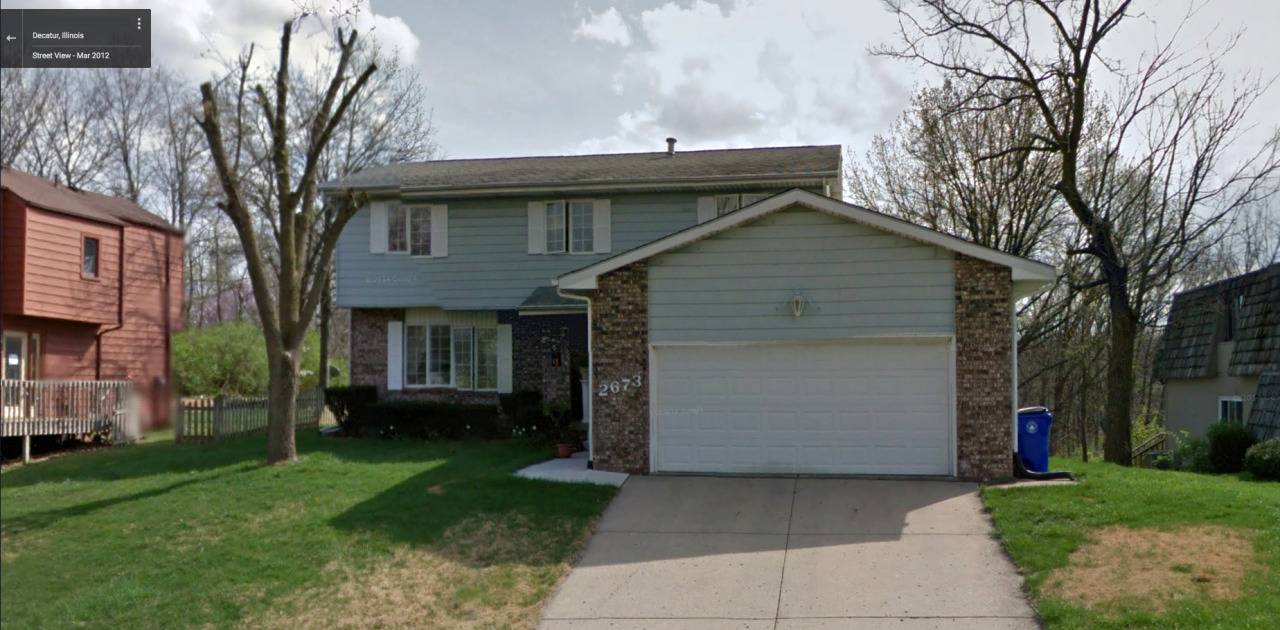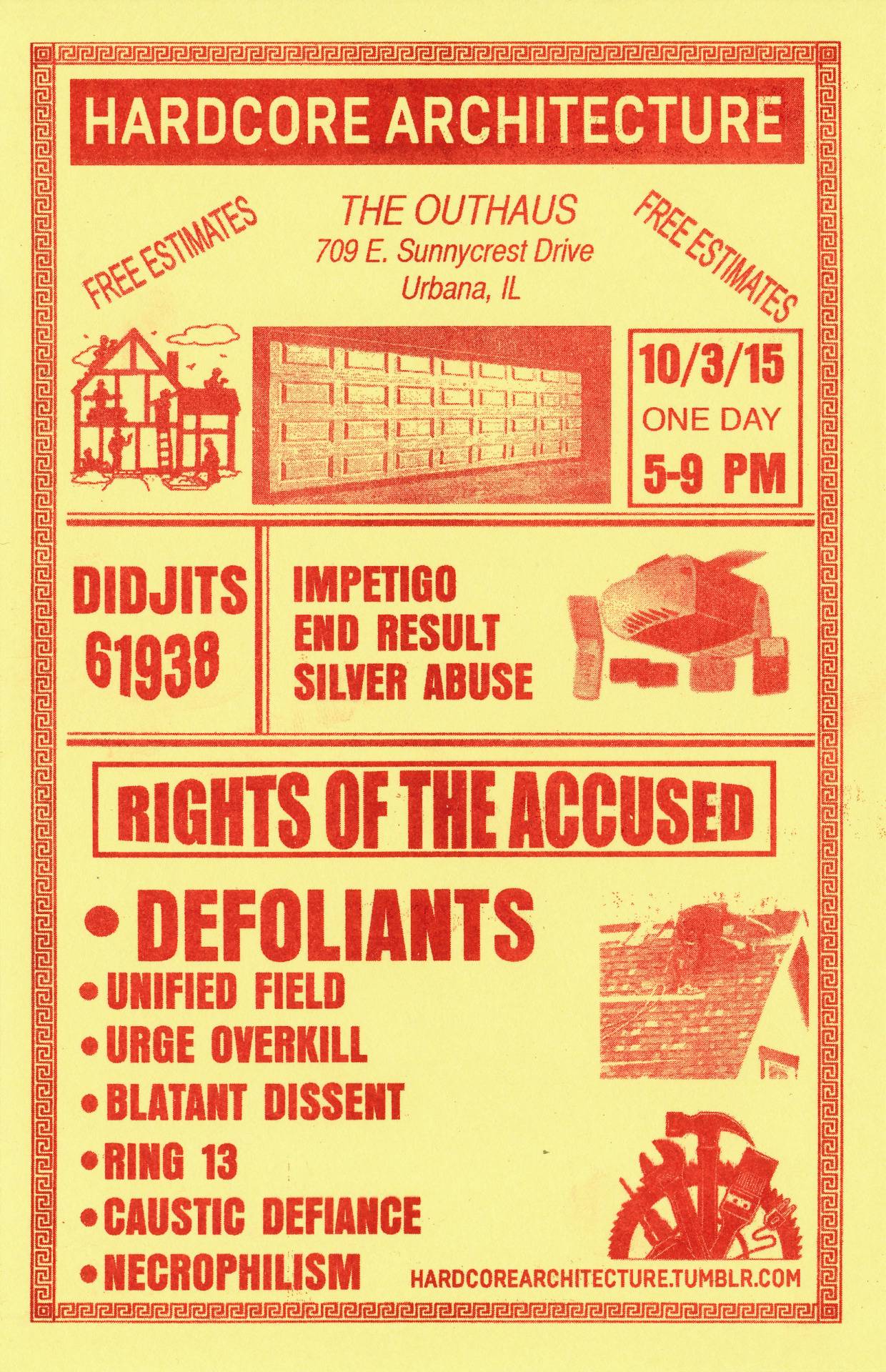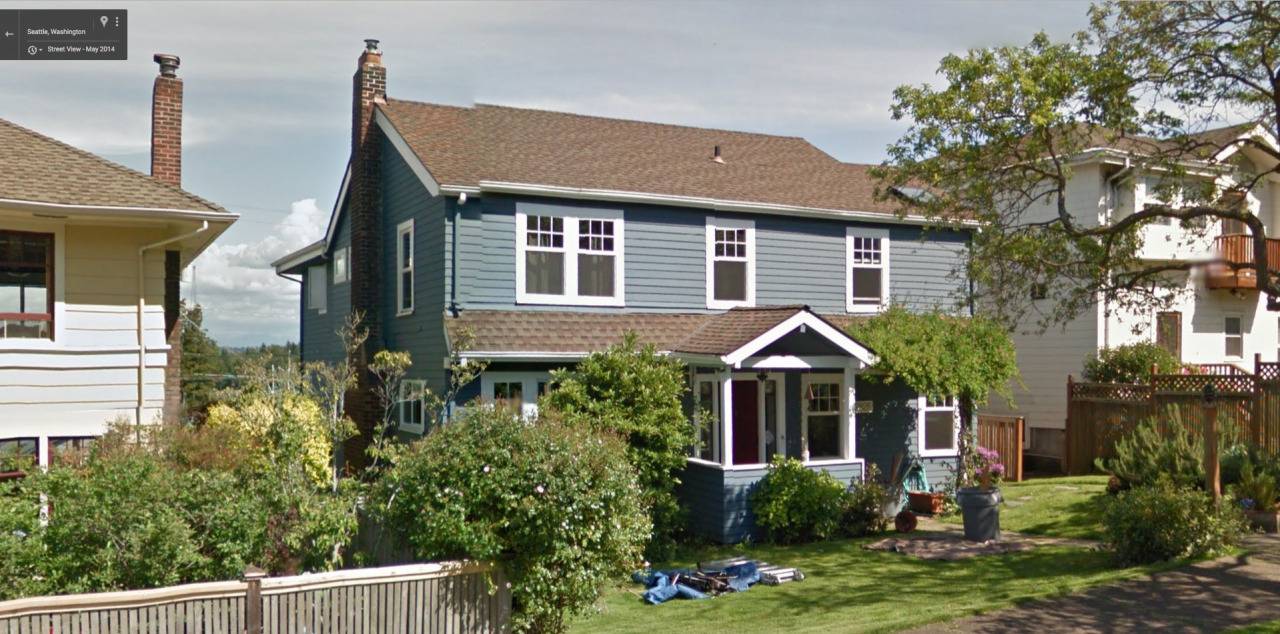Once upon a time, in the 1980s, there was no Bandcamp. No Tumblr or Facebook. Not even MySpace. But there was Maximum Rocknroll, a fanzine in which punks could hear about and order tapes and records from bands across the country. Since Google and email didn’t exist either, the addresses were printed within it’s newsprint pages. Fast forward to 2015, and we still have those pages, but we also have the Internet, Google, and Tumblr. Marc Fischer uses those elements to create Hardcore Architecture, a project in which he uses old copies of MRR to find addresses, Google Street View to find pictures of those places. The results show that bands with names like Nasal Sex, Silver Abuse and Necrophilism lived in cookie cutter suburban homes. For example, the photo above is part of the project—the home belonged to a band called Big Satan Inc. I had the pleasure of speaking with Fischer about how he started the project and some of the things he discovered along the way.
Smile Politely: I did some Googling and read a lot about Hardcore Architecture online, but can you tell me a bit about how it began and your background in art and in hardcore?
Marc Fischer: It’s a project of an initiative I started in 2007 called Public Collectors. I think after the last larger, more research-oriented project I did for that, which was about Malachi Ritscher who is an activist and music documentarian in Chicago, which is something I presented to the Whitney Biennial and then at Experimental Sound Studio’s gallery space in Chicago. I think after doing that I was again interested in trying to do something that was a bit more intensive, although I completely underestimated how much work I would wind up doing on Hardcore Architecture (laughs). But, the basically I started listening to that kind of music in around, say, 1986 when I was about 16 years old, and probably by 1987 discovered Maximum Rocknroll, saw my first issue of that magazine, which if people don’t know is this collectively run magazine, basically focusing on punk and hardcore and other underground music that started in Berkeley in 1982, so about five years in I saw my first issue of it. It was super important for me, just starting to learn about underground music and not really sure where you would find things or where you would hear about or read about new releases. I was just discovering zine culture so picking up an issue of that and it being completely filled with addresses and interesting descriptions of things, listings for fanzines, all of that just was a total revelation. And another more recent thing is just that three years ago my wife and I bought a house and I was spending a lot of time on Google Street View just looking at real estate listings…trying to understand different neighborhoods in Chicago, and at some point I was just looking at some music publication that reviewed some metal band’s demo tape, and I was like, “Oh, I wonder what you find when you type that address into Google” and of course it was this completely normal, banal home, but I realize that that was just a very different side of that kind of music.
SP: That seems to be the case with a lot of the houses you’ve found.
Fischer: Yeah, I don’t know exactly what I was expecting, but having listened to that music and being familiar with quite a few of the bands that are on the Tumblr, and also some of those bands sent me their demo tapes to review when I did a zine. So as I moved a little later into the 1980s, it was interesting, at the time that I was discovering that stuff I wasn’t really thinking at all or had my own associations about different cities, but you know, New York is an enormous place and there’s just a huge variety of what a home looks like in Yonkers for a band that you think of as being from New York City, and a group from the Lower East Side in the 1980s. Sometimes it was quite surprising.
SP: Did you notice any trends of places that became more gentrified or places that deteriorated?
Fischer: I think it’s hard to know without really knowing the histories of each area of each city or each part of the city, so you have to remember the reviews that i’m using as a source of addresses are from 1982 to 1989, and then google streetview didn’t start until 2007 and most of the addresses are more from 2012 or something like that, so there’s about a 30-year or more spread between when these people were living there, I mean some places I think people who were associated with these bands may still be there, or their parents or something, but it’s hard to know. There are places where you see these photos of a few homes that have been boarded up and I assume they were not boarded up when the people were living there. Or there’s one thing like, one of the houses associated with a member of the band Poison Idea, sometimes I’ll use real-estate websites, listings, just to make sure the home wasn’t built after the review was written if I’m suspicious of that. And this is one of the members of that band if you spin streetview around you’ll see this really expensive-looking condo building right across the street. i’m sure property values are much, much, much higher than they were at the time that that person lived there. They have this totally modest house but everything around it has changed enormously. And that’s the case where it’s just incredibly obvious to someone who doesn’t know Portland, you can tell from the style of what was built across the street. But I’ve seen discussions online where people have talked about the way things have changed. It would be so case-by-case, and there are about 400 houses on the site now.

Necrophilism
The address given for their “Dead Girls Don’t Say No” cassette in Decatur, IL 62521. Source: MAXIMUM ROCKNROLL, issue no. 35, April, 1986. Street view date: March, 2012. Sample quote from the review: “Is this misogyny or childish ghoulism?” (TY).
Above: an example of one of Fischer’s Tumblr Posts that happens to be from Decatur, IL.
SP: Do you have the old copies of Maximum Rocknroll or do you source them from somewhere?
Fischer: The time period I’m working with for now is about 79 issues, and I think I have about 25 or 30 issues from that period. But it’s kind of amazing, Chicago’s biggest public library, Harold Washington Library Center, actually has every issue of Maximum Rocknroll, and that’s very unusual. Actually the current main coordinator at Maximum Rocknroll really enjoys the project and I think if I wanted to get help from them directly, they would probably be great about it. But actually I can go to my public library and just take pictures of all the pages, all the reviews that I need and go home and look for the addresses. But yeah, it’s very fortunate because there are almost no libraries that have every issue.
SP: Do you ever read current issues of Maximum Rocknroll?
Fischer: I hadn’t really looked at it in quite some time and did pick up a recent issue and was really interested in the ways it’s changed…It’s both retained a lot of the same qualities it’s always had but it’s also changed in some interesting ways.
SP: There’s no addresses in it anymore, obviously.
Fischer: Yeah, actually that’s an important thing. They still review demos but so many of them are just posted on bandcamp and soundcloud. So they still review people’s first releases but for the most part you’re not sending $3 to get a cassette in the mail, you’re going online or they’ll provide someones email address and you can contact them and figure out what’s possible.
SP: I think it is interesting that they still don’t post their content online. It’s still very much a print thing. They still require to send a physical copy too and it’s still very much a thing in the punk scene like, “Oh MRR reviewed a record.” It still speaks to a certain underground, offline nature of punk.
Fischer: Yeah and each issue has so much information in it that it would look sort of terrible as a blog to try and scroll through that much content. They do make PDF versions now, I believe, of the publication you can buy online, which make sense, but it’s not given away. It’s still astonishing how much material they collect for print every month.
SP: Why did you decide to come to Urbana with this show?
Fischer: I’ve known Bert Stabler and Katie Fizdale who run Outhaus for quite some time and Bert and I have worked on a couple things together when he was living in Chicago. And the first exhibit of this project was a similar situation, it’s a space called The Franklin in Chicago, which is a structure that’s probably 10 by 10 feet or so, maybe not even that large, built in the backyard of two artists Edra Soto and Dan Sullivan, and first they had invited me to do something there, not anything specific and I realized this would just be perfect because they’re presenting exhibits at this totally domestic home address and the outside of their house is a small, single-family home. It could be one of many homes in the project. So I can’t remember if I asked Bert and Katie if they were interested, or if they invited me, but I really liked the idea that it is a project hosted in someone’s home for this in the way that people volunteered their addresses with these bands, and then the way we’re doing the show is it’s just one day, you either attend or you miss it. Everything fits pretty easily in my car and I’m gonna drive down and stay with them and drive back, but I’ve been talking with a friend who has a little guest house behind her home in Los Angeles so we’d like to be a show over there. There’s no reason that it couldn’t happen in other spaces, but it just seems particularly sweet to work with these very modest spaces that people create within their own means rather than some larger institution of some kind.

SP: It is kind of perfect.
Fischer: Even this little house, it looks like a mini version of some of the smaller houses that are in the project so there’s just a really nice visual serendipity.
SP: I saw your letter about the Chicago Architecture Biennial, about Rahm and BP. It seems like you’re very aware and politically minded. Is politics otherwise involved in this project at all other than that?
Fischer: There’s ethical decisions that I’m making constantly about just respecting the privacy of people who are still living at the homes. There hasn’t really been an obvious place to insert politics in a very direct way, but it’s sort of this stupid email kind of fell into my lap. It’s like, oh, this is sort of like the politics of the bands that are included in the project. It comes through partly in that there’s a politics in choosing to focus on this whole underground network and reminding people that this exists and that people in all kinds of living situations, not just big cities, are involved in experimental music culture and often had challenging political beliefs that probably counter many of the people that lived around them. That’s still kind of played out. I’ve done a couple interview booklets and one interview i’m planning on doing is with someone in San Francisco who uses Google Street View a lot as a way of, he deals with housing activism and is particularly interested in homes where people have been evicted and their buildings are being used as Airbnbs and there are little visual cues that kind of can help signal that that’s happening. There might be a little lockbox or something that guests use and you can see stuff like that on Street View. So I think there will also be other things that come out in the future that have a bit more of a specifically political point of view embedded in the project.
SP: It seemed like in the little clips of the review you included with the photos, a lot of times it will say, “They’re very political,” but won’t really say anything more. But I guess that’s the style of MMR.
Fischer: Yeah, actually one of the changes I think is that the reviews, a lot of them are three times longer than they used to be. Early on 50 words would be generous. A lot of them are very, very short. Unless there’s something controversial about the band, then maybe it’s like 100 words, but that’s pretty uncommon, but there’s not too much there for the most part.
SP: I really liked the inclusion of those little clips though, because reading through it I had never heard of most of the bands, and reading that made me want to actually check it out, and I was able to find a few of them.
Fischer: Yeah, quite a lot of that stuff is on YouTube and there’ve definitely been people who’ve been using the project as a way of finding new music which I’d never really thought about at all. It’s a really nice development.
SP: It’s ‘cause it’s on the internet and they’re not going to be looking at old issues of MRR. Most people don’t go to the library and scan a bunch of MRR issues.
Fischer: Oh they have these bound volumes and a lot of them look like they’ve never been opened, like they came back from the bindery. I think a lot of people just wouldn’t think the library would have something like that. They’ve never asked.
Hardcore Archtecture will be exhibited in Urbana for one day only at the Outhaus on Saturday at 4 p.m.








